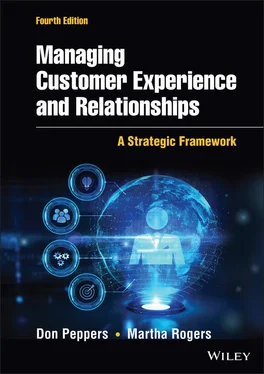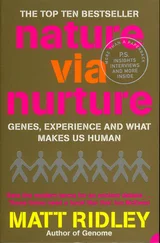1 ...8 9 10 12 13 14 ...30 The four Ps all, of course, relate primarily to the aggregate market rather than to individual customers. The market being considered could be a large mass market or a smaller niche market, but the four Ps have helped define how an enterprise should behave toward all the customers within the aggregate market:
1 Product is defined in terms of the average customer—what most members of the aggregate market want or need. This is the product brought to market, and it is delivered the same way for every customer in the market. The definition of product extends to standard variations in size, color, style, and units of sale as well as customer service and aftermarket service capabilities.
2 Place is a distribution system or sales channel. How and where is the product sold? Is it sold in stores? By dealers? Through franchisees? At a single location or through widely dispersed outlets, such as fast-food stores and ATMs? Can it be delivered directly to the purchaser?
3 Price refers not only to the ultimate retail price a product brings but also to intermediate prices, beginning with wholesale; and it takes account of the availability of credit to a customer and the prevailing interest rate. The price is set at a level designed to “clear the market,” or the highest price that will sell the product easily and widely, assuming that everyone will pay the same price—which seems only fair because everyone will get the same product. And even though different customers within a market actually have different levels of desire for the same product, the market price will generally be the same for everybody.
4 Promotion has also worked traditionally in a fundamentally nonaddressable, noninteractive way. The various customers in a mass market are all passive recipients of the promotional message, whether it is delivered through mass media or interpersonally, through salespeople. Marketers have traditionally recognized the trade-off between the cost of delivering a message and the benefit of personalizing it to a recipient. A sales call can cost between $300 and $500 (a 2012 Center for Exhibition Industry Research study put the average cost of a business-to-business [B2B] sales call at $596),e but at least it allows for the personalization of the promotion process. The cost per thousand (CPM) to reach an audience through mass media is far lower but requires that the same message be sent to everyone. Ultimately, the way a product is promoted is designed to differentiate it from all the other competitive products. Except for different messages aimed at different segments of the market, promotion doesn't change by customer but by product.
aE. Jerome McCarthy, Basic Marketing: A Managerial Approach (Homewood, IL: Irwin, 1958), is now in its 16th edition, and has been substantially updated.
bPhilip Kotler, S. C. Johnson Distinguished Professor of International Marketing, Kellogg School of Management, Northwestern University (emeritus), is widely known as the father of modern marketing. His textbook Marketing Management, coauthored with Kevin Keller, has become the foundational text for marketing courses around the globe. First published in 1976 by Prentice Hall, it is now in its 16th edition.
cPhilip Kotler, Marketing Management: Analysis, Planning, Implementation, and Control , 9th ed. (Upper Saddle River, NJ: Prentice Hall, 1997), pp. 92–93.
dPhilip Kotler, Kotler on Marketing (New York: Free Press, 1999), pp. 116–120.
eBloomberg Business, “Sales Moves Beyond Face-to-Face Deals onto the Web,” January 10, 2013, available at: https://www.bloomberg.com/news/articles/2013-01-10/sales-moves-beyond-face-to-face-deals-onto-the-web, accessed August 17, 2021; “The Cost of a Sales Call,” 4D Sales, accessed February 3, 2016, available at: http://4dsales.com/the-cost-of-a-sales-call/, accessed August 17, 2021.
Continuing Roles for Mass Media and Branding
Communicate to nonusers who have not yet raised their hands.
Build image and brand identity.
Establish a brand position with nonusers to help users make a statement about their own image.
INITIAL ASSESSMENT: WHERE IS A FIRM ON THE CUSTOMER STRATEGY MAP?
Recognizing that two families of technology have mandated the competitive approach of building customer value by building customer relationships, we can map any organization—large or small, public or private, for-profit or nonprofit—by the level of its capabilities in the arenas of interacting with customers and tailoring for them. A company would be rated high on the interactivity dimension if it knows the names of its individual customers and if it can send different messages to different customers and can remember the feedback from each one. A low rating would go to a company that doesn't know its customers' identities, or does but continues to send the same message the same way to everybody. On the tailoring dimension, a firm would rate highly if it mass-customizes in lot sizes of one; it would rate low if it sells the same thing pretty much the same way to everybody. Based on its rating in these two dimensions, a company can be pinpointed on the Enterprise Strategy Map (see Exhibit 1.2), which includes four quadrants:
Quadrant I: Traditional Mass Marketing. Companies that compete primarily on cost efficiencies based on economies of scale and low price. Companies in this quadrant are doomed to commoditization and price competition. EXHIBIT 1.2 Enterprise Strategy MapSource: Don Peppers and Martha Rogers, Ph.D., Enterprise One to One (New York: Doubleday/Currency, 1997).
Quadrant II: Niche Marketing. Companies that focus on target markets, or niches, and produce goods and services designed for those defined customer groups. This more strategic and targeted method of mass marketing still offers the same thing the same way to everyone, but for a small, relatively homogeneous group.
Quadrant III: Database Marketing. Companies utilize database management to get better, more efficient use of their mailing lists and other customer information. Generally focused primarily on continuation of traditional strategies but at lower costs to serve.
Quadrant IV: Learning Relationships. These are based on individual analytics. Companies use data about customers to predict what each one needs next and then are able to treat different customers differently and increase mutual value with customers.
In Quadrants I through III, the focus is still primarily on the product to be sold, with an eye to finding customers for that product. In Quadrant IV, the direction of the strategy changes; the Quadrant IV company focuses on a customer and finds products for that customer.
To realize the highest possible return on the customer base, the goal of an enterprise will be to move up and to the right on the Enterprise Strategy Map.
To move up on the Enterprise Strategy Map, an enterprise has to be able to recognizeindividual customers' names and addresses, or at least coded identities, to send different messages to different customers, and to remember the responses of each.
To move to the right on the Enterprise Strategy Map, an enterprise has to be able to increase its production and logistics flexibility. The most flexible production would entail customizing and delivering individual products for individual customers. The least flexible would be mass-producing a standardized product or service for a large market. (We talk more about customization in Chapter 10.)
COMPARING MARKET-SHARE AND SHARE-OF-CUSTOMER STRATEGIES
The story goes that in 1996, the executives at Barnes & Noble bookstores invited Jeff Bezos, the founder of a startup named Amazon.com, to lunch, with a proposition. Amazon.comhad not yet made any profit (and would not, for its first 28 quarters in a row), so the nice guys at the well-established bookstore offered, as a favor to Jeff, to buy him out—before they launched barnesandnoble.com, the online version of the bookstore chain. They argued that Jeff's relatively unknown brand would not stand up to their highly popular name and that he should make some money on his software and systems. He declined.
Читать дальше












